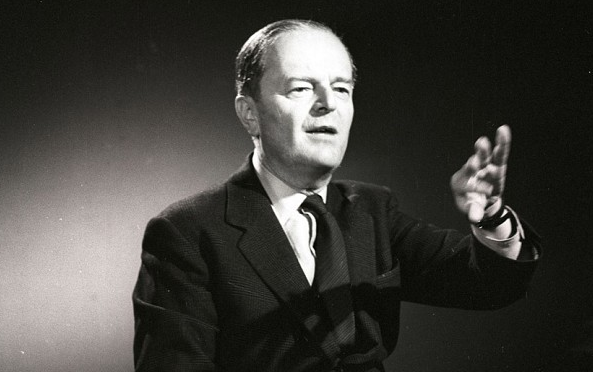
Music moves to centre stage in this week’s installment, The Pursuit of Happiness, examining a period when art and literature tended to stagnate. Beginning in France, we travel to the German lands of the 18th Century as Sir Kenneth Clark explores the complex harmony and symmetry in the works of Bach, Handel, Haydn, and Mozart, and their relation to the art and architecture of the Baroque and the Rococo styles. These changes in fashion began as a reaction to the Classicism of Versailles, but ultimately signalled the epochal cultural shift towards Romanticism that implied a rejection of civilisation itself.
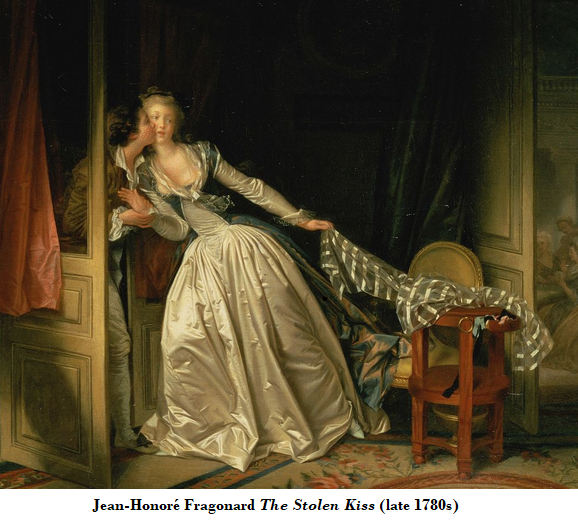
Stagnation … except for Music: Culturally, it was a time of stagnation:
when poetry was almost dead, when the visual arts were little more than a shadow of what they had been, when the emotional life seemed almost to have dried up… Only … music expressed the most serious thoughts and intuitions of the time.
Absolutism & the Sun King: Clark begins by stressing the dominance of France over the rest of Europe, beginning under ‘Sun King’ Louis XIV, who reigned from 1643 until his death in 1715. It was the Age of Absolutism, when monarchs across Europe insisted that they alone had total power and authority over society. “This meant a rigidly centralized, authoritarian government” favoured at the palace of Versailles, to where the French court moved in 1682.
Versailles: Its all-pervasive influence transformed the previously violent and aggressive aristocracy, so that, as Colin Jones put it in his History of France (1994) “the turbulent warriors of the Wars of Religion became the foppish courtiers of the Sun King.”
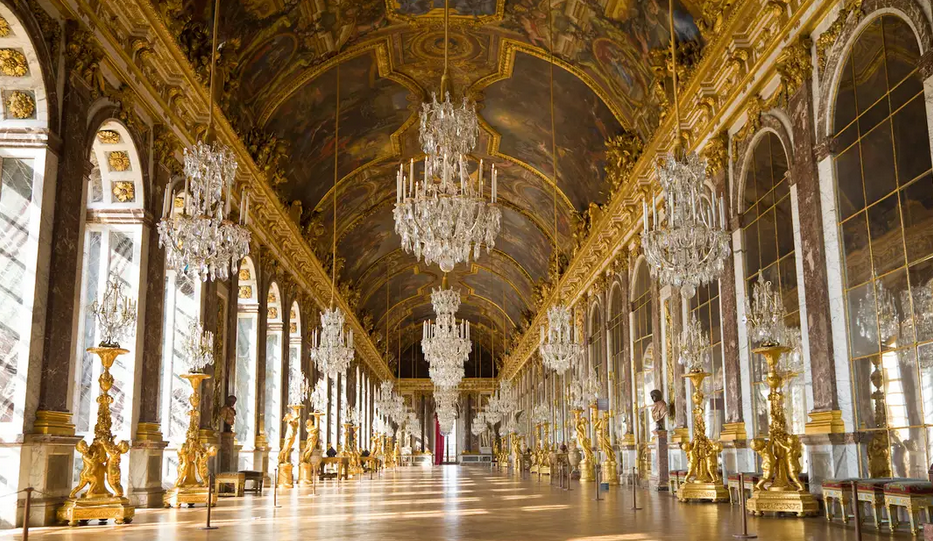
Clark notes that
Versailles (above) would be widely copied by aspiring absolutist monarchs throughout Eur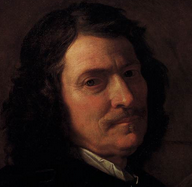 ope. It operated as an ideological mechanism of absolute power, as the centre of a kind of ‘theatre state’ in which the main actor, the monarch himself, performed a range of power rituals emulated by other monarchs across the continent.
ope. It operated as an ideological mechanism of absolute power, as the centre of a kind of ‘theatre state’ in which the main actor, the monarch himself, performed a range of power rituals emulated by other monarchs across the continent.
Classicism: The court was determined to “domesticate and ‘classicize’ culture and to control all art and culture in order to glorify the monarchy. Nevertheless, according to Clark,
‘the classic style, applied to all the arts, was one of the summits of European civilisation.’ It produced ‘two sublime dramatists, Corneille and Racine, and a great and noble painter, Nicolas Poussin (left).’
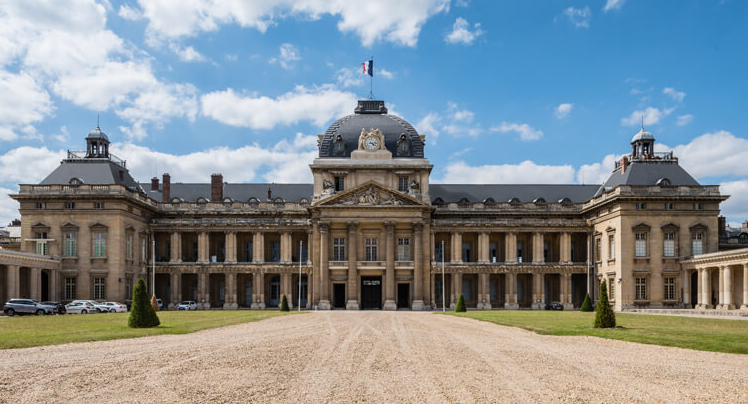
Architecture: “French Classicism also produced magnificent architecture,” exemplified by the Louvre and Ecole Militaire (above) It is the architecture of “a great metropolitan culture” proclaiming “the grandeur achieved through the authoritarian state.” But it is also exhibits
a certain inhumanity, as it is the work of civil servants,
not an individual craftsman, such as Borromini, who championed the High Baroque in Italy.
Northern Baroque: As it transpired,
French Classicism was eminently not exportable [while] the High Baroque of Rome was exactly what the north of Europe needed.
This was especially the case in Germany which was characterized by “a social order that was absolutely the reverse of the centralized bureaucracy of France.”
The German Difference This was because the Baroque style suited
the craftsman tradition of the Germanic north, a tradition serving a social order that was absolutely the reverse of the centralized bureaucracy of France.

Consequently, “the finest buildings we look at are not palaces, but local pilgrimage churches, deep in the country.” This decentralization applied not only in art and architecture but in music as well:
the formative element in German art and music lay in the multiplicity of regions and towns and abbeys – all competing for their architects and choirmasters, and relying on the talents of their local organists and plasterers.
The Bach Family: In music this is illustrated by the family of Johann Sebastian Bach:
the Bachs were a family of local musical craftsmen out of which there suddenly emerged one of the great geniuses of Western Europe.
They had been professional musicians for 100 years, “so that in some districts the very word ‘Bach’ meant a musician.”
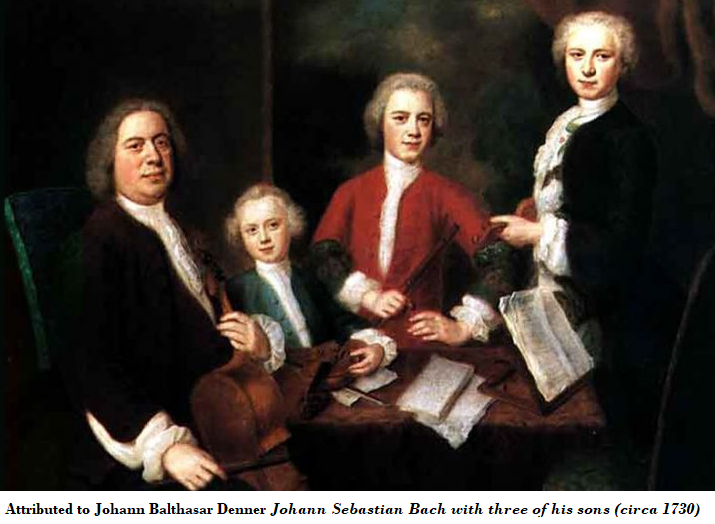
Bach’s universal genius rose out of the high plateau of competitive musical life in the Protestant cities of northern Germany.
On one hand his life “was that of a conscientious, somewhat obstinate, provincial organist and choirmaster;” on the other,
he was universal [and] some of the great moments in Bach’s oratorios of the Passion have the solemn simplicity and deep religious feeling of Giotto’s frescoes, and the towering polyphony has the quality of Gothic architecture.
Luther’s Influence: These reflections raise an interesting question. The Protestant leader, Martin Luther, had a major influence of German music, writing many hymns, and the Lutheran Church encouraged church music.
This was very important because, given the iconoclasm directed by the Reformers towards images,
the choir and the organ became the only means through which men could enter the world of spiritualized emotion.
Calvinist Iconoclasm: However, the Calvinist churches took the extra step and extended their iconoclasm to music and especially to organs. These had become highly valued within communities and were usually elaborately decorated. Nevertheless, as part of
“their resolute purification of the Christian rite [the Calvinists] prohibited organs and destroyed them.” In so doing, “they caused more distress [to the communities] than had ever been caused by the destruction of images.”
Triumph of Religious Themes: Moreover, this period is also often called the Age of Reason; the tenor of thought was anti-religious and the general way-of-life “ostentatiously profane.” Nevertheless, despite these pressures, the great art of the time was religious art — especially in music. Consequently, “there was nothing to set beside the Matthew Passion or the Messiah or the abbeys and pilgrimage churches of Bavaria and Franconia.”
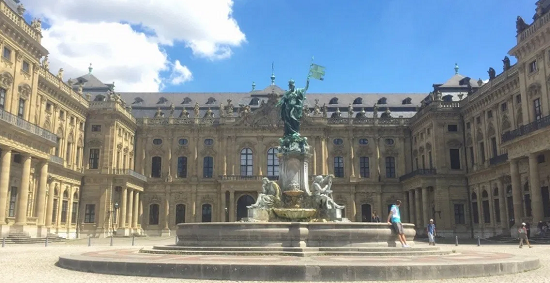
Neumann & Tiepolo: Clark turns to the architectural creations of Balthasar Neumann and the work of Giovanni Battista Tiepolo in the Bishop’s Palace at Wurzburg (above), where the ceiling (below) represents the four continents.
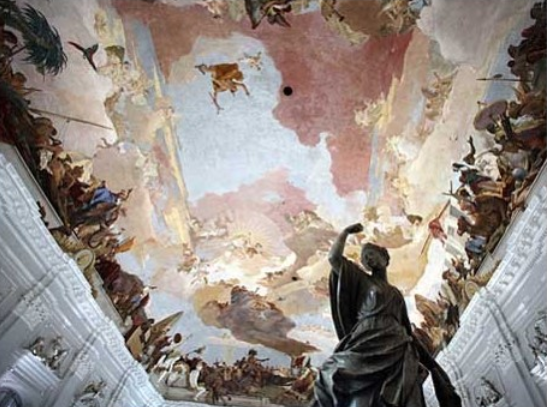
The Cost of Culture: Such lavish premises involved a tremendous financial imposition on the peasant communities that supported these German bishops, dukes, electors, etc. This raises questions about democracy and culture, because, these leading figures were frequently “remarkably cultivated and intelligent men.” And their
competitive ambitions benefited architecture and music in a way that the democratic obscurity of the Hanoverians in England did not.
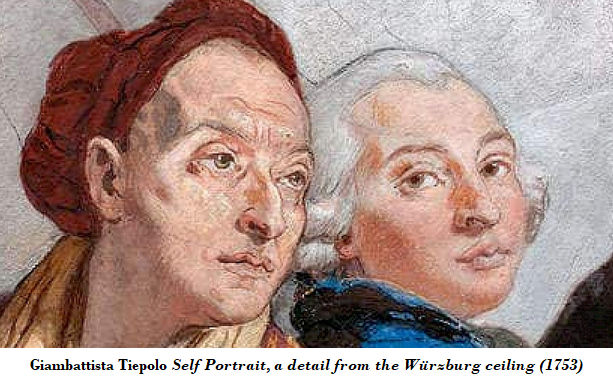
Handel: Clark believes that the art of Giovanni Battista Tiepolo goes well with the music of George Frederick Handel, to whom he now turns. Clark observes that
great men have a curious way of appearing in complementary pairs [and] the two great musicians of the early 18th Century, Bach and Handel, born in the same year, 1685, fall into this pattern of contrasting and complementary personalities.
Baroque & Rococo: Clark seeks to distinguish two artistic styles, Baroque and Rococo, that appear to have much in common, especially the florid nature of their creations. He insists that “there is a real difference between them, which means something in the history of civilisation.”
Baroque was an Italian invention that first came into being as religious architecture and expressed the emotional dimensions of Catholic Christianity.
Rococo was a Parisian reaction to the heavy Classicism of Versailles and was
provocatively secular … It represented a real gain in sensibility. It achieved a new freedom of association and captured new and more delicate shades of feeling.
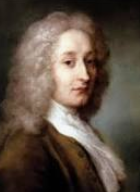 Antoine Watteau: “All this is expressed through the work of one exquisite artist, Watteau (right).” Born in Flanders he derived much of his style from Rubens,
Antoine Watteau: “All this is expressed through the work of one exquisite artist, Watteau (right).” Born in Flanders he derived much of his style from Rubens,
but instead of a hearty Flemish acceptance of life, Watteau, who was a consumptive, discovered something in himself that had hardly ever been seen in art before: a feeling of the transitoriness of life, and thus, the seriousness of pleasure.
He was also the prophet of a “new sensibility” that revealed itself in a “more delicate understanding of the relations between men and women.” Clark feels all this is best 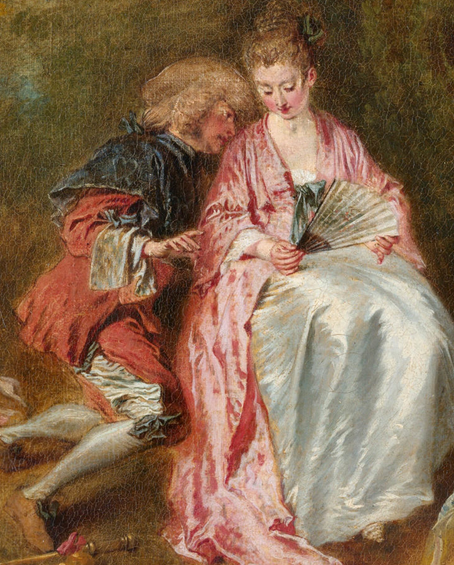 revealed in “his masterpiece, the Pilgrimage to Cythera. (detail at left)”
revealed in “his masterpiece, the Pilgrimage to Cythera. (detail at left)”
Clark sees in it “the lightness and sharpness of a Mozart opera,” but “also a sense of drama,” as the young men and women share a few brief hours on the Isle of Venus, the goddess of love.
Cupids buzz about, pushing reticent couples closer together; others have already settled into their passionate trysts; while down below some prepare reluctantly to board the golden boat that will take them back to the everyday world.
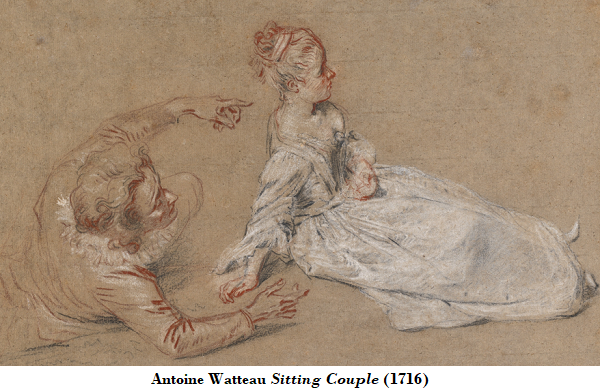
Walter Pater: Next to love, Clark tells us, Watteau cared most about music and
life itself is conceived as a kind of listening.
Here he is quoting the 19th Century aesthete, Walter Pater, who declared that “all art aspires to the condition of music”, in its identification of form and content. (Pater’s influential book, The Renaissance (1873), was denounced as ‘rococo Epicureanism’, and became notorious for allegedly luring sensitive young men into hedonistic and dissolute ways.)
Haydn: Once again Clark opposes two composers: despite the superficial similarity of their music
the two greatest musicians of the second half of the 18th Century were very different characters and the difference comes through in their music.
Joseph H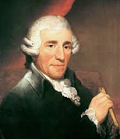 aydn (left) composed innumerable pieces so that weary folk ‘might enjoy a few minutes of solace and refreshment’ and his music complemented the Rococo style, especially in churches, where
aydn (left) composed innumerable pieces so that weary folk ‘might enjoy a few minutes of solace and refreshment’ and his music complemented the Rococo style, especially in churches, where
the faithful are persuaded not by fear [as with the Gothic style] but by joy. To enter them is a foretaste of Paradise.
Mozart: Unlike Haydn, who was 24 years his senior, Wolfgang Amadeus 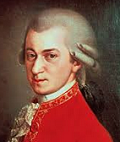 Mozart (right) never came fully to grips with the burden of genius or the dangers to which it exposed him, especially as a naïve young prodigy in a world of jealous mediocrities. While
Mozart (right) never came fully to grips with the burden of genius or the dangers to which it exposed him, especially as a naïve young prodigy in a world of jealous mediocrities. While
he loved the clarity and the precision that had been brought to perfection in the music of his time,
by composers like Haydn, he had other preoccupations. One was
that peculiar kind of melancholy, a melancholy amounting almost to panic, which so often haunts the isolation of genius.
The other was “a passionate interest in human beings, and in the drama of human relationships,” a drama that he seems never quite to have mastered.
Opera & Rococo At this point Clark turns to opera,
one of the strangest inventions of Western man [and one that] could not have been foreseen by any logical process.
Moreover, it was such
“an extravagant and irrational entertainment,” that “it seems surprising that it should have been brought to perfection in the Age of Reason.”
However, it makes sense once it is seen as “the greatest artistic creation of the Rococo mentality.” It flourished in Catholic capitals such as Vienna Munich, and Prague, where opera houses — Vienna’s is pictured below — became like great churches dedicated to “this new profane religion.”
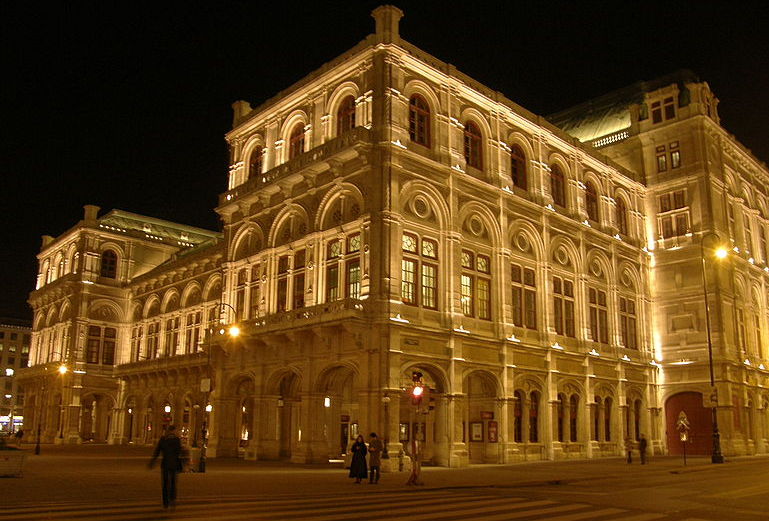
Why Opera?
What on earth has given opera its prestige in Western Civilisation? Why are people prepared to sit silently for three hours listening to a performance of which they do not understand a word?
Why indeed! Clark suggests it is partly because it involves a great display of skill.
But, chiefly, because it is irrational [and] what is too subtle to be said, or too deeply felt, or too revealing or too mysterious — these things can only be sung!
Don Giovanni: Such thoughts bring us back to Mozart, and to his great opera (composed with librettist Lorenzo da Ponte), Don Giovanni, which Clark invokes to illustrate his argument. Audience feelings about this work have always been complex. Clark’s attitude is typical — Don Giovanni is “the most ambiguous of hero-villains,” involved in a “pursuit of happiness and love” that has become “complex and destructive.” However, from any civilised perspective the Don is a loathsome monster: a rake who has had his way with literally thousands of women across Europe, and is also a rapist, a murderer, a bully, a liar, a braggart, and an egomaniac… and yet the Don has fascinated audiences for over 230 years and the opera is one of the most performed in history.
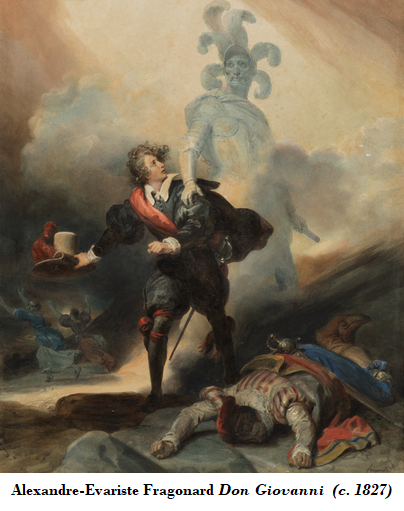
Reckoning & Final: Ultimately, the Don is confronted by the statue of the Commendatore, the father he had killed after assaulting his daughter; he had scornfully invited the statue to dinner, and now it has arrived in supernatural form. Offered a last chance at salvation, the Don contemptuously rejects the invitation to repent, and he is set upon by demons, which drag him down to Hell in an horrific scene. Then, in the Finale, all those whose lives have been blighted by the Don sing a simple sextet, telling of their joy in seeing him gone and map out their simple mundane futures free of him. The message is simple:
Such is the end of the evildoer: the death of a sinner always reflects his life.
The Romantic Revolt: The ambiguity of which Clark speaks was reflected in the decision in many productions, right from the outset, to delete this simple, even banal Finale. As Isaiah Berlin explains in The Roots of Romanticism (1999, p.123.):
The reason is this. Here is this vast, dominating, sinister symbolic figure, Don Giovanni, who stands we know not for what, but certainly for something inexpressible.
He stands, perhaps, for art as against life, for some principle of inexhaustible evil against some kind of philistine good; he stands for power, for magic, for some sort of infernal forces of a superhuman kind.
The opera ends with an enormous climax, in which one infernal force is swallowed by another, and the vast melodrama rises to a volcanic culmination, which is meant to cow the audience, and to show them amidst what an unstable and terrifying world they lived…
[But] then suddenly this philistine little sextet follows, in which the characters simply sing peacefully about the fact that a rake has been punished, and good men will continue their ordinary, perfectly peaceful lives thereafter. This [scenario] was regarded as inartistic, shallow, bathetic, and disgusting, and therefore eliminated [from the opera]
Cultural Shift: This embrace of the infernal and rejection of the ordinary signalled the end of the bourgeois world. Opera audiences fell deeply under the spell of geniuses like Mozart and da Ponte. They were emotionally and morally transported as they entered the magical world these masters conjured up for them. The response to Don Giovanni through the following century reflects a fundamental shift in European cultural consciousness — from the Classical to the Romantic. From the late 18th Century onwards it seems many people became eager to reject their bourgeois lives and the civilization that underpinned it (at least in their imagination). To express this repugnance they embraced various ‘vast, dominating, sinister symbolic figures …who stand we know not for what.’
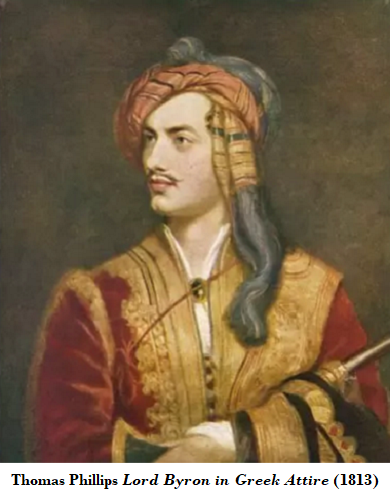 Over the next century many such figures emerged. Most prominent was the Byronic hero, who cut a swathe through society while pursuing a romantic life of commitment lived in person by the poet and then by those who tried to emulate him. Others followed, including Heathcliff, the tortured romantic anti-hero whose relentless, all-consuming passions dominate Emily Brontë’s Wuthering Heights. Later came Friedrich Nietzsche’s Übermensch, the amoral superman who lived in a realm ‘beyond good and evil’, and became the icon of anti-bourgeois radicalism, of both left and right. He was followed by Bram Stoker’s Dracula, a demonic force whose sheer power of will drew his victims into infernal submission and cast them into the realm of the ‘undead’.
Over the next century many such figures emerged. Most prominent was the Byronic hero, who cut a swathe through society while pursuing a romantic life of commitment lived in person by the poet and then by those who tried to emulate him. Others followed, including Heathcliff, the tortured romantic anti-hero whose relentless, all-consuming passions dominate Emily Brontë’s Wuthering Heights. Later came Friedrich Nietzsche’s Übermensch, the amoral superman who lived in a realm ‘beyond good and evil’, and became the icon of anti-bourgeois radicalism, of both left and right. He was followed by Bram Stoker’s Dracula, a demonic force whose sheer power of will drew his victims into infernal submission and cast them into the realm of the ‘undead’.
However, as Clark concludes, the story of this pivotal shift from Classical to Romantic belongs to another phase of civilisation, and a future episode.
 Sign In
Sign In 0 Items (
0 Items ( Search
Search









Wonderful. Keep them coming.
This series has inspired me to re-view the series on YouTube.
Thank you, MB, for all your summaries and hard work.
Like DG above, the series and your posts have inspired me to revisit it on YouTube.
Who would have thought Luther had a “fine tenor voice.
See John Goodman’s essay on him in the Quadrant magazine, April 2019: “Martin Luther and the origins of political authoritarianism”.
Who knew that Bach and Handel did share something in common, but it was not their musical styles. Both were born in the same year, 1685, both went blind from copying musical scores in poorly-lit interiors, both were operated on – alas, unsuccessfully – by the same surgeon.